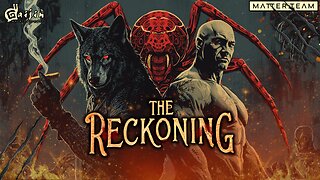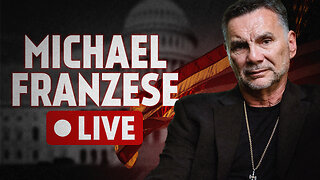Premium Only Content

Are Religions Just Big Cults?
Source:
https://www.youtube.com/watch?v=tjWdH1utXp4
This video explores the fundamental question of whether religions are simply cults that have managed to scale over time. It argues that at their core, both cults and religions share striking similarities in their control over individuals, elevation of leadership, strict belief systems, and demand for absolute loyalty.
The video highlights several key parallels:
Shared Tactics: Both employ tactics like thought reform, isolation, emotional manipulation, and authoritarian leadership, as identified by sociologists like Robert Lifton and Margaret Singer. Many major religions, like Christianity and Islam, began with charismatic figures and initially exhibited features that modern psychology would classify as "cultic," including centralized control, absolute doctrines, and the persecution of dissenters.
Psychological Predispositions: The human brain is predisposed to group loyalty and obedience to authority. Religious systems, much like cults, leverage these instincts by embedding narratives that reward conformity and punish dissent. Questioning core tenets in both often leads to ostracism or worse.
Scale and Legitimacy: A primary difference in public perception is scale. Cults are typically small and marginalized, whereas religions gain size and legitimacy through historical accidents, military conquest, and political alliances. The power of numbers reframes them, with large, long-standing organizations like the Catholic Church no longer viewed with the same suspicion as smaller, more recent groups.
Legal and Societal Distinctions: Religions often receive tax exemptions, legal protections, and societal privileges that cults do not, reinforcing the perception of them as fundamentally different, despite similar internal mechanisms.
Philosophical Overlaps: Both demand faith in unverifiable claims, assert moral authority from supernatural sources, and structure adherents' lives with rigid behavioral codes, extending into private life.
Control Mechanisms:
Behavioral Control: Both dictate behavior through commandments and rules, and control information by restricting access to competing viewpoints.
Emotional Manipulation: Guilt, fear, and promises of eternal reward or punishment are used to ensure compliance.
Indoctrination: Early childhood immersion, before critical faculties are fully developed, is a common tactic, making it difficult to question beliefs later due to deep emotional and social investment.
Isolation: Historical and modern religious communities, similar to cults, use isolation to maintain control and reinforce the group's worldview.
Financial Extraction: Both often demand significant financial commitments from members, sometimes with promises of spiritual consequences or divine favor.
Authoritarian Leadership: Leaders in both claim exclusive insight or prophetic authority, with questioning leadership often equated to questioning the divine.
Sexual Control: Regulation of sexual relationships, marriage, contraception, and condemnation of non-heteronormative identities are common mechanisms of control.
Fear of Leaving: Apostates in both cults and religions face severe penalties, including vilification, shunning, excommunication, or even violence, acting as powerful deterrents.
Cultural Integration: Religions are deeply embedded in cultural identity, national holidays, and family traditions, making them seem inseparable from personal identity. Their political dimensions also obscure cult-like origins, as ties to governance grant them legitimacy.
Cognitive Biases: Human brains are predisposed to agency detection, and religious beliefs often persist due to their social utility in fostering tight-knit communities. Confirmation bias and survivorship bias protect both systems from self-correction.
Historical Evolution: Many major religions, including Judaism, Christianity, and Islam, began as small, often persecuted groups with extreme beliefs that, through time, success, and political integration, evolved into global institutions. The distinction often rests on historical contingency rather than substance.
Modern Challenges: The internet and increased access to information challenge the isolation that sustained many religious and cultic systems, leading to more deconversions.
Enduring Mechanisms: Regardless of the label, the underlying machinery of both cults and religions reflects enduring mechanisms of human psychology, tribal identity, and social engineering, including the use of loaded language, selective historical memory, charismatic leadership, and the weaponization of guilt.
The video concludes that the labels "religion" and "cult" are more social judgments than objective categories, reflecting size, power, and historical integration into society rather than intrinsic differences in their structures, tactics, or psychological impacts. Both cultivate loyalty through unprovable claims, emotional manipulation, social isolation, and authoritarian control, promising ultimate meaning in exchange for unquestioning devotion. The primary distinction is often in degree, longevity, and public acceptance.
-
 1:24:47
1:24:47
iCkEdMeL
4 hours ago $7.83 earnedFrom Music to Murder? D4VD’s Tesla Horror Story
36.6K12 -
 LIVE
LIVE
This is the Ray Gaming
2 hours agoNEW LOOK WHO DIS? | Rumble Premium Creator
77 watching -
 LIVE
LIVE
TinyPandaface
1 hour agoYour FACE is a Gaming Channel! | Escape Memoirs: Mini Stories - #2
33 watching -
 2:37:14
2:37:14
ChrisBoken
3 hours ago $0.47 earnedDayZ - Our Server Goes Live
7.04K -
 LIVE
LIVE
Spartan
4 hours agoFirst time playing Black Myth Wukong
44 watching -
 LIVE
LIVE
TwinGatz
4 hours ago🔴LIVE - Strike Out Saturday | CS2 | Counter-Strike 2 | New Subs = Case Opening
51 watching -
 5:53:05
5:53:05
Simulation and Exploration
7 hours agoHow well does this play on a controller? Future console players check this out!
19.9K1 -
 LIVE
LIVE
MrR4ger
9 hours agoTHE THREE SPLOOGES (THE RECKONING) - ACTIVE MATTER w/ AKAGUMO & TONYGAMING
56 watching -
 1:25:04
1:25:04
Michael Franzese
7 hours agoJames Comey, Epstein Files Block, Tylenol | Michael Franzese Live
209K69 -
 1:24:44
1:24:44
Winston Marshall
12 hours agoThe Hamas Hoax That Fooled The West...
36.6K24